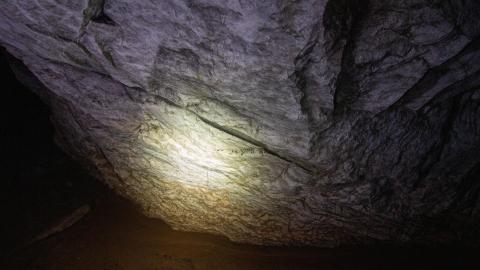Hazards
It is very, very dark inside this mine. You do not want to be without light. Bring multiple backups and extra batteries.
Bats appear to use this mine as a hibernaculum during the winter months (October to April), please refrain from entering during that time.
Depending on the angle you decide to approach from, you could encounter some caved in mineshafts that vary in depth, but are all shallow enough to climb out of. The entrance to the mine itself is located on the side of a cliff of gypsum, and there is a trail that leads right to it from the road. There is a rope to grab onto while scaling the mound of gypsum blocking a significant part of the entrance. In the mine, some parts of the floors are muddy, and others are covered with a few inches of water. There are some small trenches made by flowing water, but nothing massive. There are multiple collapsed mineshafts in the mine that once led to the surface, easily spotted by the massive mounds of dirt. In the back of the mine, there’s what is presumably a descent to the lower levels, however it is completely flooded. The water is murky, and the slope down does not appear to be gentle. Do not try to enter the water. There is a small cliff you can climb up in the deepest accessible portion of the mine, where at the top is a 15 foot sheer drop into an otherwise inaccessible part of the mine.
History
Mining began in the Hillsborough area around 1854, with the founding of the Albert Manufacturing Company and the construction of a plaster mill, which was the largest in Canada at the time. The gypsum in the area was considered to be some of the highest quality gypsum in the world, therefore the mill produced many types of plaster, of which gypsum was the main ingredient. This plaster would be shipped all over the world, helping to spread its reputation and encourage further exploitation of the gypsum in the area.
To produce the plaster, gypsum was first carved out of the mine walls, and loaded into carts to be hauled by horses to the main shaft of the mine, where it would then be lifted to the surface. The gypsum would also be mined in the 5 nearby quarries owned by the same company. Once the gypsum had reached the surface, it would be loaded onto the company’s private trains, which had been nicknamed “Tadd” and “Connie”. These trains would then take the gypsum to the plaster mill, where it would be ground down into powder and dried in bins over wood fired furnaces, which would burn through seven cords of wood per day, which was enough to heat a house for the entire winter.
The original plaster mill burned down in 1873, and was rebuilt, but burned down again in 1911. It was rebuilt, and continued producing plaster until 1980, when the Canadian Gypsum Company, who had bought the Albert Manufacturing Company in the same year closed the site. Nothing remains of the plaster mill today, having been demolished sometime after it closed.
About this location
Coordinates are approximate.
My family and I were on a trip to Nova Scotia to visit some friends, and had decided to stop in Moncton to break up the trip into smaller segments. While there, I learned about this mine, and decided to make the short drive down to go and check it out. I drove about 10 minutes into the woods on the former mine roads, found a spot to park my car, and walked in the direction of the coordinates I had found. On my way there, I discovered multiple collapsed shafts into the mine, varying from 10 feet deep to only a few inches. Once I got to the mine, I climbed up the mound of gypsum blocking the entrance, and crouched into the darkness. Upon first entering, there were some metal O rings driven into the rock to my immediate left, and some dirt piles that had been created when the mineshafts that led into the mine had collapsed. In the back of the mine, there were some ore cart tracks that hadn’t been buried by the dirt on the floor of the mine yet, suggesting that the mine was slowly filling up with dirt, probably thanks to the water constantly flowing through, and down through the collapsed mineshafts. There was also an unknown piece of machinery located off to the side, consisting of a few gears and an empty spool on some wood framing. There was also some timbering in one part of the mine at the bottom of the dirt piles, stopping the collapsed mineshafts from collapsing any further, which implies that they had started to collapse before the mine had closed, which could have been a factor in the closing.
Albums 2
07/07/22 - Albert Manufacturing Co. Mine
Apologies for some of the blurry photos, I forgot to bring my tripod and had to do longer exposures by hand.









2 years ago
Went yesterday, it was one hell of an adventure, I had a lot of fun looking for it. I kept in touch with the author to let him know about the coords and the bats in the cave. Dont go during night, I spent 2 hours looking for it because I could not see past a few feet. I though looking for a massive gypsum cliff would be easier. Stay on the trail, you dont need to go off it like we did, lots of mistakes were made on this trip and you can learn from mine!